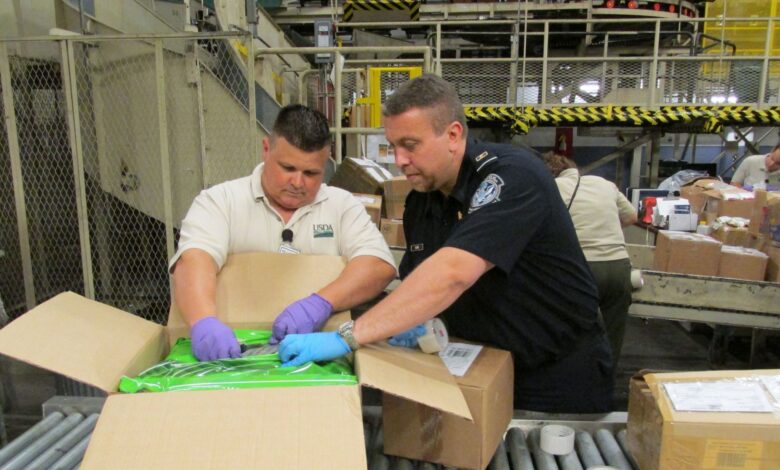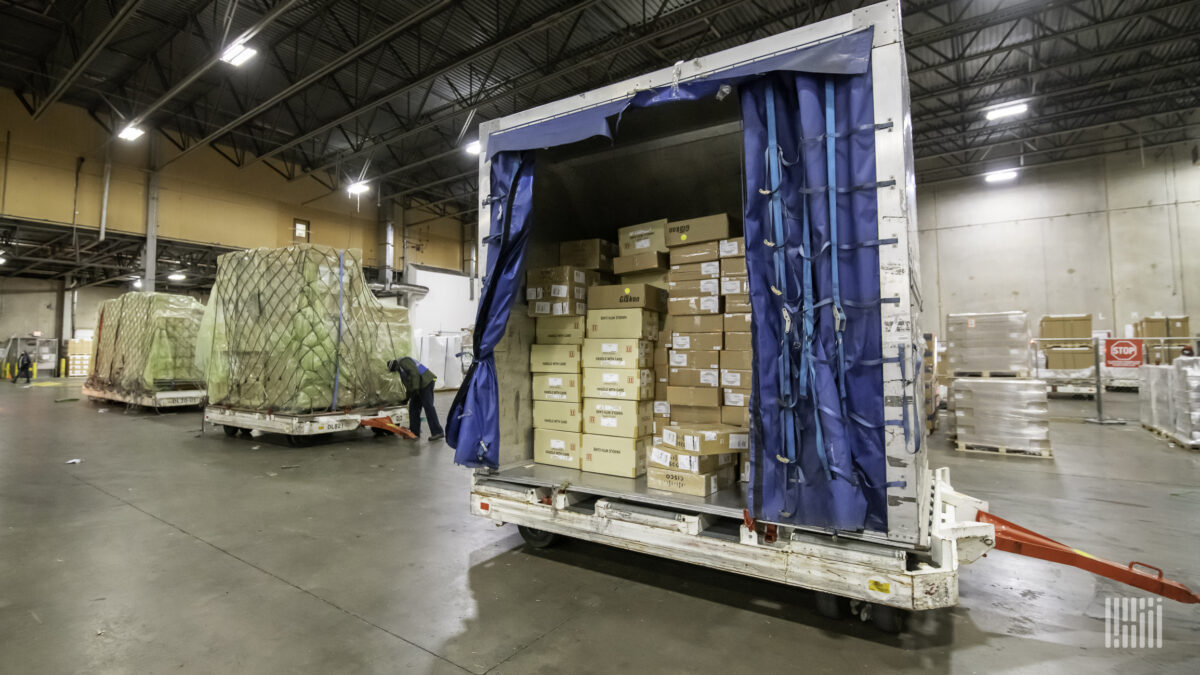US Customs tightens enforcement on low-value e-commerce trade

U.S. Customs and Border Protection has suspended several customs brokers from a program that was designed to speed entry for low-value shipments but has paved the way for an explosion of e-commerce imports from China and India that the agency is struggling to police.
CBP didn’t spell out specifics in Friday’s suspension announcement but implied the intermediaries were penalized because filings for cargo release repeatedly failed to comply with requirements that the importer use “reasonable care” to properly classify and value goods, and for late filing of required data.
Under a 2016 update to U.S. trade regulations, the aggregate retail value of articles that a single person in one day can import free of duty and taxes — and without a detailed, formal customs declaration — was raised to $800. The previous threshold to qualify for an import duty exemption was $200.
The de minimis — or minimum — threshold was changed to accommodate the growing appetite for purchases made online and shipped directly to the consumer’s door and because the duties on low-dollar imports were so small it wasn’t worth the expenditure of CBP resources to collect them, according to trade compliance experts. The rule changes led to a wave of just-in-time packages from companies such as Shein and Temu, overwhelming CBP’s ability to identify suspicious parcels and raising alarm that smugglers of fentanyl, counterfeits and other illicit products are exploiting the process.
A November 2023 report from the International Trade Commission found that so-called Section 321 shipments account for a substantial share of all U.S. e-commerce imports by quantity and that China is the leading source of de minimis imports by a large margin.
U.S. Customs processes nearly 4 million de minimis shipments a day. The number of de minimis transactions has skyrocketed 646% in eight years, from 134 million in fiscal year 2015 to 1 billion (worth more than $50 billion) in 2023 through postal, express and non-express facilities, according to the agency. It forecasts those totals will be exceeded this year.
Trade facilitation was much easier to manage when the vast majority of imports were business-to-business shipments mostly entered by hundreds of large consignees.
Most of the shipments arrive in the U.S. on commercial aircraft and vessels, but some inventory is staged at warehouses in Canada and Mexico and moved to the U.S. via ground transportation when consumers place an order.
To increase visibility and further expedite a border clearance process that relies on a carrier’s limited manifest data, CBP in 2019 initiated a test of a voluntary Entry Type 86 procedure for self-filers and brokers to electronically transmit shipment data through its trade processing platform. A key benefit of Type 86 is that it also covers goods that fall under the import jurisdiction of other agencies, such as the Food and Drug Administration, which require extra data elements. In exchange for faster processing, filers must submit more data, including a 10-digit harmonized tariff code.
Freight forwarders and customs brokers can profit if they can process the entry type in high volumes. But they also assume greater risk because if a shipper or logistics company hires them to handle Type 86 entries, they have to declare themselves as the importer of record exercising reasonable care, as opposed to just a customs broker exercising responsible supervision and control.
“CBP’s evaluation and suspension of non-compliant Entry Type 86 participants is part of a multi-layered enforcement approach to prevent abuse of the de minimis process, protect the integrity of the supply chain, and ensure that businesses comply with applicable U.S. legal requirements,” CBP Acting Commissioner Troy Miller said in a statement. “When businesses fail to comply with U.S. law, it can have far-reaching effects on the integrity of our trade system and the people reliant on the goods that flow through our ports every day. For example, bad actors are exploiting the de minimis environment to move materials used to produce synthetic drugs — like fentanyl and its analogues — and other contraband into the United States. … Any broker that has been suspended will be considered for reinstatement if it demonstrates to CBP that it has developed and implemented a remedial action plan.”
The Information reported last week that Seko Logistics, based outside Chicago, was one of the logistics companies caught in CBP’s dragnet and it was barred from the Entry Type 86 program for at least 90 days. The agency is barred by trade secrecy laws from disclosing targets of enforcement action. Seko Logistics said in a statement on Tuesday that has a nearly 100% compliance rate and has sued CBP in federal court for an explanation about why it was suspended.
Fast-fashion maker Shein, as well as marketplaces such as Temu and AliExpress, have been major catalysts for the air cargo industry in the past two years, helping to accelerate the sector’s recovery from a post-COVID downturn even as demand for other types of general cargo is flat. E-commerce shipments represent 50% of all airfreight volume leaving China, according to estimates by some logistics providers.
Raising the duty exemption to $800 opened the door for more e-commerce, but growth in online shipments didn’t take off until people changed their shopping patterns during the pandemic because the average de minimis shipment is still only worth about $50 to $60, said Lenny Feldman, managing partner at trade law firm Sandler, Travis & Rosenberg.
The big trigger, he said, occurred when electronic retailers realized they could avoid paying tariffs imposed during the Trump administration on Chinese goods by essentially unbundling consolidated shipments so that instead of shipping to an importer of record with a warehouse, each consumer is treated as a distinct consignee, opening the door to ship directly from the country of origin. And some companies that want to skirt rules against imports of goods made with forced labor are also taking advantage of de minimis.
In mid-April, trade compliance professionals warned CBP was rejecting more cross-border e-commerce shipments after it changed the automated filing system to enforce a requirement that Type 86 transactions be filed prior to, or when, the imported cargo arrives. Previously, Entry Type 86 could be filed up to 15 days after the product arrived. The update means that brokers have to file complete, accurate and timely data sets, including full product descriptions and harmonized tariff codes.
Entries filed after the cargo has arrived are rejected and held until a separate entry or appropriate entry is made, and the cargo is no longer eligible for expedited clearance.
“Failure to meet the new Entry Type 86 requirements could result in customs brokers having to manage massive volumes of formal and informal entry clearances, something that is hugely labor intensive and time consuming, and ultimately will impact their clients and end consumers,” said Laurie Cieciuch, an executive at Hurricane Commerce, in a press release. Hurricane is an AI-enabled platform that helps e-commerce companies with cross-border data sharing and compliance.
Six or seven forwarders or brokers have had their ability to file Type 86 entries revoked by CBP, according to news accounts. Feldman, whose company is extremely well connected across the import/export sector and the government, said he understands that an earlier enforcement wave kicked two or three pop-up entry filers out of the program for several years, or even revoked their import permits.
Closing the loopholes
In an April 19 speech to the National Customs Brokers and Freight Forwarders Association of America’s annual conference, Miller urged the trade community to step up provision of advanced data for low-value shipments and stop listing vague or inaccurate descriptions of the contents on the manifest.
“We are seeing many instances within the Entry Type 86 test where filers aren’t doing their part to validate the data they are submitting. We continue to see weight and value ratios that don’t make sense, vague cargo descriptions like freight of all kinds or daily necessities,” he said. “In fact, a few weeks ago, we seized two shipments that contained Xylazine, a horse tranquilizer. When added to fentanyl it is resistant to Narcan, a medication that helps prevent opioid overdose deaths. Both shipments were misclassified, had vague, one-word descriptions ‘bag’ and ‘90.’ Both shipments entered under Entry Type 86.
“We know that there are filers abusing their Entry Type 86 test by filing entries as quickly as possible and providing junk data. These individuals can file entries worth more than several thousand dollars a day without any vetting of the data to ensure accuracy. CBP has learned that these same filers are charging as little as 10 cents per Entry Type 86 transaction. As a result, highly compliant customs brokers like you aren’t participating in the test because they can’t fulfill their duty to provide accurate data to CBP. They simply cannot compete with these prices.”

“This is creating an unlevel playing field with the Entry Type 86 test environment. … To change this, CBP is increasing our enforcement efforts to ensure that compliant and responsible customs brokers are participating in the Entry Type 86 test,” he said.
Feldman said for brokers to comply, they need to invest in knowledgeable staff and technology, which will be reflected in the prices they will charge.
“You need the automation, the artificial intelligence to look at data anomalies, look at vague data descriptions, help with HTS classification and you need a human resource component,” the trade attorney said. “Do you have enough people, enough eyes and ears so that if your system finds an anomaly, someone’s able to look at it and put their head to it and say, ‘Hey, this is something that needs to be looked at again, and address it’?”
U.S. Customs is purchasing software to help analyze and target small shipments but doesn’t have enough resources to inspect most packages, said Karen Lobdell, a senior manager for Thomson Reuters’ global trade automation platform.
And the agency is trying to push industry to provide more data “because they can’t target with vague descriptions,” Lobdell added. Express carriers like FedEx and UPS are participating in a data pilot that provides CBP even more data than on the Type 86 entry in exchange for even faster clearance.
Congress sees China problem
The e-commerce loophole is also under heavy scrutiny from lawmakers on both sides of the aisle who see it as another example of China undercutting U.S. businesses on the trade front. Legislation that effectively would eliminate de minimis treatment on imports from China and require CBP to collect more information on low-value shipments has bipartisan support in both chambers.
A Senate proposal would bar Chinese exports from entry via the de minimis channel and calls for a reciprocal threshold for duty-free imports into the U.S. as U.S. exporters receive in other nations. Trade practitioners questioned the practicality of having a different de minimis standard for every country.
“If I am an apparel or other consumer product company, why would I bother with investing in domestic retail stores, warehouses and logistics operations; paying U.S. wages to a significant domestic workforce; and seeking out regional supply chains that offer duty-free market access through a free trade agreement, when I can simply centralize all of my production in the lowest-cost, lowest-standard regions of the world and convert my operations into a duty-free direct-to-consumer model? How else will any U.S. company be expected to compete against this irrational and exploitative de minimis system?” Andy Warlick, chairman and CEO of textile manufacturer Parkdale Mills, said in a December meeting with members of the House Ways and Means Subcommittee on Trade.
The E-Merchants Trade Council (EMTC), which mostly represents microbusinesses outside the United States, conservatively estimates that eliminating de minimis for shipments from China would increase the total cost of imported goods by more than $110 billion per year. An e-seller will incur an additional $61.25 in costs for a hypothetical import with a declared value of $50, including merchandise processing fees and customs brokerage fees to file a formal customs entry, it said in a March 24 letter to the House panel. The $50 item could retail for $75, resulting in a loss for the seller. Small businesses that operate on platforms such as Etsy have low profit margins and are extremely cost-sensitive. Extra fees could make it difficult for many of them to offer products online, the trade group said.
“EMTC understands that Congress is very concerned about several issues related to goods imported from China — including fentanyl, goods made with forced labor, and intellectual property rights violations, etc. However, we caution Congress from conflating these issues as synonymous with de minimis shipments as they pose challenges to sophisticated multi-national corporations that import goods from China as well,” the letter stated.
It also warned that eliminating de minimis for imports from a specific country would invite a similar response against U.S. exports. The European Union plans to eliminate the 150-euro ($163) de minimis for customs duties in a customs reform package, which will negatively impact U.S. exporters.
Feldman predicted Congress won’t change the $800 de minimis amount but could restrict or prohibit small-dollar shipments from China from receiving the benefit.
The EMTC last month proposed that CBP develop a pilot program with the U.S. Postal Service to create risk profiles of e-sellers who ship low-value packages, which would help the border agency concentrate enforcement resources on shipments from unvetted businesses. Customs already manages compliance for many traditional importers on an account basis rather than tracking each shipment. Risk profiles would be helpful because with e-commerce there is no importer of record with a physical presence in the importing country and Customs ends up holding the third-party marketplace accountable for any violations.
“The de minimis piece is really important for our country. Everyone thinks of the border as being the air border, the sea border, the land border. The new borders are our doorstep. And God forbid if someone gets a package on her doorstep with fentanyl. We have to get this right. At the same time, we can’t demonize the service providers who are drinking out of a firehose with different data elements required, depending on the mode of transportation,” Feldman recommended. “We need guidance, we need transparency, we need a level playing field, we need the same set of data that’s required, whether it’s [full entry] consumption, formal de minimis (Type 86) or not, so everyone has the same expectation with the buyer and seller, harmonized tariff schedule, commercial invoice so that you don’t have to suspend brokers.
“It’s really hard when you have a logistics provider, or forwarder, who’s feeding data from Asia or Europe or South America. Customs can’t hold them accountable. They’re going have to hold the filer accountable. So that’s a really challenging position to be in. And then to say, ‘If you’re filing a Type 86, as a broker, you too are now the de facto importer of record.’ So they the broker has to bear a lot on their shoulders. We need compliance, we need to stop the seizures, we need to stop the liquidated damage claims and, yes, some of these brokers need to evolve with automation resources to do it better. But I think CBP has been very upfront, and I commend them for recognizing it’s tough all around.”
Click here for more FreightWaves/American Shipper stories by Eric Kulisch.
Trade group wary of unfunded mandate to curtail fentanyl smuggling





